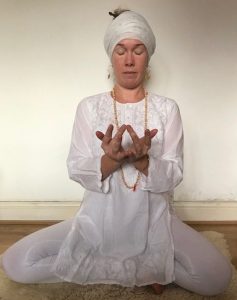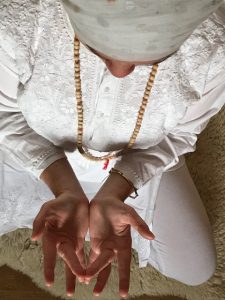
One of my biggest challenges in London is learning to negotiate the occasional tidal wave of busy commuters, and all the sharpened elbows, set jaws and aloof eyes that come with it – that rush hour that’s determined to get from A to B as fast as it can, no matter whose toes it steps on.
I struggle because it’s painful to be swept along in this tide, jostled up against those hard elbows and jutting jaws. And I also struggle to remain separate from it. When everyone around me is practically sprinting to their destination, I have to make much more of an effort to stay present, to continuously remind myself that I don’t need to run with them, that I can take my time. But collective consciousness is a powerful thing, and often I’ll find myself speeding up to keep up.
I had no idea when I started the Bhandu Dya Kriya, aka the Meditation for Developing Your Human Kindness, that it would be integral in helping me face this challenge. And it absolutely has, in the sweetest, most compassionate and gentle way.
During the past 10 weeks, I’ve become more aware of my relationship to the humanity of this ‘rat race’. I am much more present with the grit that I so often see in the stressed faces around me, and I am much softer and compassionate with that grit (Ah, and there’s the title – developing human kindness). I am also much more present with any edginess that nudges into my being when I find myself in a mid-rush hour tide, and it quickly softens, just under the gaze of my awareness. There’s a key word to this meditation, and that’s softness.
According to the instructions, this is a meditation that we need to take slowly and patiently. Start with 11 minutes for the first week, then increase the time by one minute a week up to 31 minutes. I’m on week 10, so am up to 20 delicious minutes. Not only is it teaching me softness, grace and compassion, but it’s instilling in me patience too.
I love this little gem so much. Please try it for yourself! The effects have accumulated with practice, so definitely try it for an extended period.
 Instructions for The Kriya for Developing Your Human Kindness (from KRI’s website)
Instructions for The Kriya for Developing Your Human Kindness (from KRI’s website)
Bandhu means “brother or comrade;” Dya means “kindness;” and Kriya means “action.”
You must have sufficient practice of this kriya before you attempt to do it for more than eleven minutes. After one week of practice, you can add one minute to your practice. Thereafter, each week you can add one more minute, up to a total time of thirty-one minutes. Under no other circumstances may you do this kriya for more than eleven minutes.
“This most ancient kriya is a total energy. The magnetic field is totally interlocked into the psyche of the self. The aura is totally messed up (re-arranged) and totally projected. The breath, the praana, is controlled by the rhythmic eight (strokes) and then it is projected out as sound. It lacks nothing.
“It is a very secret and selective kriya. Give it a lot of reverence and do it with a lot of love and devotion. Anything which deals with praana is related to the Praanpathi, the one who gives you the praana, which sustains your life. Do it with a lot of reverence, very calmly.
“I have to share with you these great and secret kriyas and I do this in good faith. But that does not mean that you can betray that faith. Teach it (Bandhu Dya Kriya) a maximum of eleven minutes, then in a week add one minute (as stated above). It feels good, but don’t overdo and lose touch with your environment. It makes a person beyond excellent. It expands you in time and space and everything (in ordinary life) may start to look little to you. It gives one the capacity to rise above time and space.”
Mudra: Rest your elbows alongside your rib cage. Place your hands in front of your chest, palms facing upward, with the two Mercury (pinkie) fingers touching and the outside part of the base of the palms touching. Keep the Sun (ring) fingers and the Jupiter (index) fingers straight and the thumbs pulled back. Touch the tips of the Saturn (middle) fingers so that they form a triangle. The mudra is held before the heart center in a comfortable, prayerful position, but it does not touch the chest.
Posture: Sit in Easy Pose with your spine straight, chin in and chest lifted. Place your hands in the mudra.
Breath: Inhale through the nose in eight strokes (break the inhalation into eight equal segments with a slight pause separating each part so that there is a distinct beginning and end to each segment. In other words, you are inhaling in eight separate “sniffs.” Each stroke is about one “nose length.” You can feel the breath travel the length of the nose from the nostrils to the eyebrows. Each count of a stroke is about one second, so the eight stroke inhalation takes about eight seconds).
Exhale completely and totally with a whistle through the puckered lips. Continue for 11 minutes, no longer unless you follow the instructions above.
Sat nam x